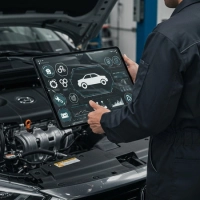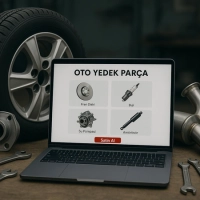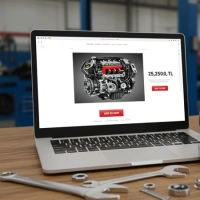
Inventory Management Strategies with ERP
Competition in the automotive aftermarket is increasing daily. Rising customer expectations, increasing product variety, and supply chain fluctuations are making inventory management more critical than ever. Holding excessive inventory freezes capital and increases storage costs, while under-stocking leads to customer loss, service delays, and reputational damage.
The most effective way to achieve this balance is to digitalize inventory processes and manage them in real time with advanced ERP (Enterprise Resource Planning) software .
1. Main Challenges in Spare Parts Inventory Management
There are many factors that make inventory management complex in the auto spare parts industry:
- Wide range of products: Parts suitable for thousands of brands, models and variants need to be stocked.
- Demand fluctuations: Seasonal maintenance periods, economic conditions or sudden market movements change inventory needs.
- Distinction between equivalent and original parts: Different supply and pricing policies are required for each group.
- Import and logistics processes: Imported parts in particular have long and variable delivery times due to customs and transportation.
When this complex structure is managed with manual methods or simple spreadsheets, the risk of error increases and inventory costs get out of control.
2. Contribution of Inventory Management with ERP
Auto spare parts ERP software digitizes inventory management end-to-end, making the process more transparent and efficient.
The main advantages are:
- Real-time inventory tracking: Branch and warehouse-based stock levels can be viewed instantly.
- Minimum and maximum stock warnings: Critical levels are predetermined and the system automatically notifies.
- Demand forecasting and order planning: Order suggestions are prepared using historical sales data and trends.
- Supplier integration: Orders are automatically planned and delivery times are monitored.
- Equivalent part matching: Equivalent part codes are managed on a single screen.
In this way, it is possible to get rid of excess inventory, optimize cash flow and fully respond to customer demands.
3. Strategies for Optimum Stock Levels
Some of the strategies that can be implemented thanks to the ERP infrastructure are:
a) Prioritization with ABC Analysis
Parts are divided into groups A, B and C according to sales volume and profitability.
- Group A: Fast-turnover, high-profit products. More frequent orders and lower safety stock are required.
- Group B: Medium-volume products, periodic orders are sufficient.
- Group C: These are products that are sold infrequently. If possible, it's advantageous to work from supplier stock.
b) Seasonal and Trend Analysis
ERP reports allow you to analyze past sales data. For example, by planning for increased demand for seasonal products like winter tires or antifreeze, you can reduce the risk of stock shortages.
c) Dynamic Reorder Point
Instead of fixed order levels, dynamic order trigger points are set that update themselves based on sales trends. This prevents sudden changes in demand from causing problems.
d) Integrated Purchasing and Supplier Management
The ERP system records supplier lead times and pricing history. Multiple supplier options for critical parts protect against supply chain disruptions.
4. Warehouse and Logistics Efficiency
Spare parts ERP software optimizes not only numbers but also in-warehouse operations .
With barcode or RFID integration:
- Find out which part is on which shelf in seconds
- Fast picking and packing
- Automatically tracking returns and warranty processes
becomes possible.
This optimization both increases staff efficiency and minimizes shipping errors.
5. The Competitive Advantage of Digitalization for Business
Correct inventory management supported by ERP means not only cost control but also customer satisfaction and sustainable growth .
- Delivery times are shorter and order errors are reduced.
- Capital is used more effectively.
- Scalable infrastructure is provided for new branches or e-commerce channels.
Therefore, for spare parts companies , the transition from manual or simple software to ERP-based smart solutions is no longer a choice, but a prerequisite for standing out from the competition.
Conclusion
Maintaining optimal spare parts inventory not only translates to cost savings, but also customer satisfaction, fast delivery, and sustainable profitability. Penamo's auto parts ERP software , with its real-time inventory tracking, demand forecasting, supplier integration, and flexible reporting features, is a powerful solution for businesses seeking to achieve this goal.
With the right ERP strategy, it is now much easier to minimize errors in inventory management, stand out from the competition, and increase profitability.























